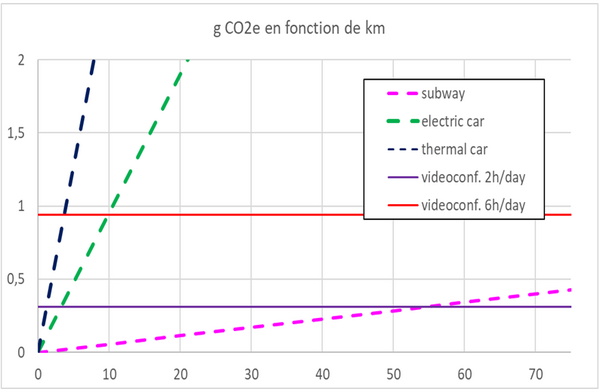Is teleworking the answer to the carbon cost of commuting?
CUMIN (C) March 2023
Besides rebound effects, teleworking has itself a carbon cost that is not lesser
that the carbon cost of mobilities used for commuting.
With carbon cost of commuting (see CUMIN fact sheet « Mobility »), teleworking could be seen as a tangible answer as it cancels those travels.
What is the cost of teleworking?
Teleworking is part of digitilization's carbon cost which, as it is now known, represents a 7st continent from 2 to 3 time the size of France [1]. The assessment of GreenHouse gases (GHG) of digital activities and those of teleworking varied a lot for a long time. It is finally thanks to lockdown, which accelarated work from home, that studies on teleworking carbon cost became more numerous and gave the relatively reliable figure of 157g CO2e per hour of ZOOM vidioconference [2]. This very low figure seems to defy the carbon cost of all types of motorised mobility.
Does teleworking emit less CO2e than commuting ?
It depends. In the framework of the Carbon Care action of the PANDA European project [3] and of CUMIN, a comparative study was realised from the specific case of a reseach team of L2EP lab at the University of Lille. This study takes into account the GHG emissions of members team' real mobility and compares them to other mobility schemes (100% thermal vehicle, 100% subway, 100% electrical vehicle) and vidioconference (according to the average of hours of meetings people spent daily during lockdown) [4] (see Appendix).
Type of mobility of the team members | real mobility | 100% teleworking | 100% subway | 100% thermal vehicle | 100% electrical vehical |
Emissions GHG (kg CO2e) | 10 958 | 1 861 | 456 | 20 327 | 7 603 |
Emissions of GES (kg CO2e) / mobility schemes
This study shows that the 100% thermal vehicle scheme is the higher emitter of GHG. It also shows that, in the specific case of this research team of the Unversity of Lille, the 100% subway scheme is the lowest emitter of GHG and not the 100% teleworking schem as one might have first imagined.
What about the other travels?
It has been shown that teleworking creates « rebound effets » [5]: a star-type mobility from home all along the day instead of a mobility integrated to the main travel (from home to office); the vehicle, parked at home, can be used by other members of the family or the relocation of the house in peri-urban and rural areas, all this contribute on the contrary to increasing the GHG emissions [6].
Besides rebound effects, teleworking has itself a carbon cost that is not lesser that the carbon cost of mobilities used for commuting.
Références
[1] F. Bordage, « Empreinte environnementale du numérique mondial », GreenIT.fr, p. 11.
[2] R. Obringer et al., « The overlooked environmental footprint of increase Internet use », Resources, Conservation & Recycling, 167, 2021, doi: 10.1016/j.resconrec.2020.105389.
[3] project-panda.eu/carbon-care/
[4] A. Bouscayrol et al., « Comparisons of GHG emissions of on-site working and teleworking: case study of a research group », 2021 IEEE Vehicle Power and Propulsion Conference (VPPC), Gijon, Spain, 2021, pp. 1-4, doi: 10.1109/VPPC53923.2021.9699220.
[5] Greenworking & ADEME, « Étude sur la caractérisation des effets rebond induits par le télétravail », 2020. (www.ademe.fr/mediatheque)
[6] E. D. Viana Cerqueira et al., « Does working from home reduce CO2 emissions? An analysis of travel patterns as dictated by workplaces », Transportation Research Part D: Transport and Environment, vol. 83, June 2020, doi: 10.1016/j.trd.2020.102338.
Appendix – case study : real and 100% videoconference schemes
The comparative study realised in the framework of the European PANDA project and CUMIN [4] takes into account GHG emissions of real mobility of the team of 21 members. In order to get figures per year (kg CO2e), the travel mode, the emissions factor and the number of km were taken into account (table 2).
These figures are presented in parrallel with those of the teleworking GHG emissions for each of the 21 members of the team for the same period of work. In order to get them (kg CO2e), the average of hours of meetings people spent daily during lockdown was used to define the number of hours of videoconference. This figure and the videoconference's factor of emissions have been taken into account (table 3).
Table 2 : GHG emissions according to usual travel mode Table 3 : GHG emissions according to 100% teleworking scheme
The comparison of the 2 tables' figures shows that teteworking can lower GHG emissions in some cases (in green in table 3). We also see that teleworking can raise the environmental impact of some persons because the usual travel mode emit less GHG than videoconference (in red in table 3). The other cases have globally the same amont of GHG emissions.











